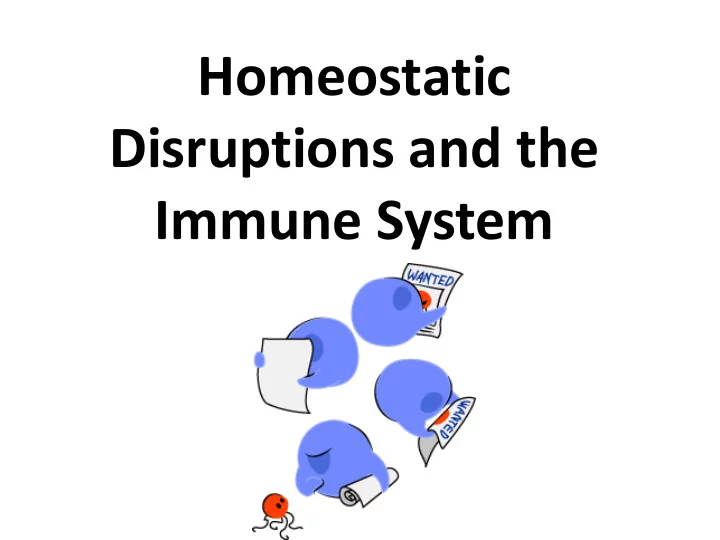

Homeostatic Disruptions and the Immune System
Disruptions to Dynamic Homeostasis • Disruptions at the molecular and cellular level affect the health of the organism = death and disease Examples include: – Dehydration – Pathogens – Toxins – Allergens
Pathogens • Infectious agent that causes disease • Microorganisms (bacteria, parasites, fungi) and viruses
Toxins • Biologically produced poison Examples include: - bee stings - black widow spiders - botulinum toxin
Allergens • Any substance (antigen) that causes an allergic reaction (hypersensitive immune response) Common allergens: - pollen - pet dander - antibiotics - foods - insect stings
Defense Mechanisms
Animal Nonspecific Defenses (Innate Immunity) • Physical and chemical barriers (skin, mucous membranes, stomach acids, enzymes, “good” bacteria) • Inflammation and swelling (mast cells, macrophages, and neutrophils)
Plant Nonspecific Defenses • Plants have molecular recognition systems that trigger systemic responses • Infection triggers chemical responses that destroy infected and adjacent cells, results in a localizing effect Example: Hypersensitive Response in Plants
Vertebrate Specific Defenses (Acquired or Adaptive Immunity) • Develops only after exposure to a pathogen • Involves an antigen-antibody interaction • Two types of specific immune responses: 1. Humoral Response 2. Cell-Mediated Response
Very Important Cells • Phagocytic cells (macrophages, dendritic cells) • Natural Killer Cells • B cells • Helper T cells • Cytotoxic T cells
Macrophage • Responsible for nonspecific and specific defenses • Engulfs and digests any foreign debris that does not match the healthy cells of the body (bacteria, viruses, cancer cells, “marked” cells)
Natural Killer Cells – Born to Kill! • Do not require activation • Detect abnormal surface proteins of virus- infected cells and cancer cells • Cause cell death (do not engulf cells)
B cells and T cells (lymphocytes)
B cells • Plasma B cells (effector cells) produce antibodies
T Cells • Helper T cells and cytotoxic T cells (effector cells)
B Cell and T Cell Antigen Receptors • ~100,000 antigen receptors per cell
Antigen-Antibody Interaction
Antigen-Antibody Interaction • Antigen: any substance that causes the immune system to produce antibodies (“antibody - generating”) • Antibodies: Y-shaped proteins that are produced by B cells , identify and neutralize pathogens (antigens), specific shapes to antigens
Humoral Versus Cell-Mediated Response
Humoral Response
Humoral Response • Defends against pathogens in the body fluids (blood, lymph, interstitial fluids) • Involves B cells • B cells secrete antibodies against specific antigens
Humoral Response (Primary)
Humoral Response (Secondary)
What do antibodies do?
Primary and Secondary Immune Response
Cell-Mediated Response
Cell-Mediated Response • Attack body cells that have been infected with pathogens • Involves T cells (Helper T cells and Cytotoxic T cells) and B cells
Cell-Mediated Response
T Cells
Helper T Cells Three ways to “help” the immune response: • Stimulate B cells to produce more antibodies to the specific antigen • Activate and increase the number of macrophages • Activate cytotoxic (killer) T cells for the cell mediated response
Helper T Cells
Cytotoxic (Killer) T Cells • Target and destroy cells infected with pathogens
MHC (Major Histocompatibility Complex)
CD4 • Accessory protein that helps to bind the helper T cell to “presented” antigen on the surface of the macrophage
HIV and Helper T Cells
Dengue Virus Life Cycle Malaria: Human Host Cloning an Army of T Cells
Recommend
More recommend